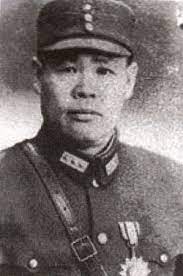Sun Lien-chung (1893-), subordinate of Feng Yü-hsiang who entered the service of the National Government in 1930 and became known as an outstanding field commander during the Sino-Japanese war. In July 1945 he became governor of Hopei and commander of the Eleventh War Area, later the Paoting pacification office. In 1948 he served as personal chief of staff to Chiang Kai-shek.
Hsiunghsien, Chihli (Hopei), was the birthplace of Sun Lien-chung. He attended the Paoting Middle School and then, in 1913, joined the regiment commanded by Feng Yü-hsiang (q.v.). He soon rose to become a battalion commander in Feng's 16th Mixed Brigade. After serving with an artillery regiment and receiving advanced military training he rejoined Feng's forces. In the final stage of the Northern Expedition, Feng's armies were reorganized as the Second Army Group. Sun served under Lu Chung-lin (q.v.), the commander in chief of the Northern Route Army of the Second Army Group. This force took the field against the Fengtien troops in northern Honan in April 1928 and played an important role in the final drive northward to Peking. By this time, Sun had risen to the rank of general. In September 1928 Sun Lien-chung was appointed governor of Tsinghai, and in 1929 he succeeded Liu Yü-fen as governor of Kansu. In the latter post, he was charged with administering the military affairs of Kansu, Tsinghai, and Ninghsia. After participating in the unsuccessful Yen-Feng movement (for details, see Feng Yü-hsiang; Yen Hsi-shan), Sun, like many other officers who had served under Feng Yü-hsiang, entered the service of the National Government. He was given command of the Twenty-sixth Route Army and was appointed Kiangsi director for purging the countryside with responsibility for "banditsuppression" activities in the rural areas of Kiangsi, Hupeh, Hunan, and Honan. For five years, he was one of the workhorses of the anti-Communist campaigns, and he played a prominent role in the 1934-35 pursuit of the Long March forces. His work in the "banditsuppression" campaigns ceased only when the Sian Incident of December 1936 (see Chiang Kai-shek; Chang Hsueh-liang) and the formation of a united front brought these campaigns to an end. Sun's work during this period was recognized by the Kuomintang in 1935 at its Fifth National Congress. Sun was elected to the party's Central Supervisory Committee. After the Sino-Japanese war began in July 1937, Sun Lien-chung led his Twenty-sixth Route Army to Liuliho, on the southern outskirts of Peiping. His troops gradually were forced into Shansi, which fell to the Japanese in November 1937. Sun then was promoted to commander in chief of the Second Group Army, in which capacity he took part in the battle of Taierhchuang (for details, see Li Tsung-jen) in March-May 1938. For his performance in that critical battle, he was awarded the Blue Sky and White Sun decoration. After withdrawing from east China, he contributed to the defense of Wuhan until October, when he was forced to withdraw northward. In the spring of 1939, he participated in the battle of Tangho, recovering it from the Japanese. By this time, Sun had established himself as one of the Nationalists' outstanding field commanders. In 1939 he was made deputy commanding officer of the First War Area, and he later held the equivalent post in the Sixth War Area. In July 1945 the National Government appointed him commanding officer of the Eleventh War Area and governor of his native Hopei. At war's end, he was ordered to effect the Nationalist takeover of Hopei, Shantung, and Chahar and to administer matters pertaining to the Japanese surrender. With the aid of American forces in the Chinwangtao, Tientsin, Peiping, and Tsingtao areas, he was able to achieve his objectives with great speed. As the civil war between the Nationalists and the Chinese Communists gained impetus, Chiang Kai-shek began shifting officers and reorganizing civil and military bodies. In March 1947 the Eleventh War Area was reorganized as the Paoting pacification office, with Sun Lien-chung as pacification commissioner and Hopei-Paoan commander. In the autumn of 1947 he participated in the battle of the Peiping-Tientsin-Paoting triangle and won one of the Nationalists' ever-rarer victories. He was appointed commander in chief of defense for the Nanking area in the spring of 1948 and personal chief of staff to Chiang Kai-shek that autumn. When Chiang retired from office in January 1949, Sun also resigned. Sun then went to Taiwan, where he became a member of the strategy advisory commission after the National Government retreated to Taiwan in December 1949.

孙连仲
字:仿鲁
孙连仲(1893—),冯玉祥的部属,1930年后在国民政府任职,在中日战争期间闻名的卓越的前线司令官。1945年任河北省主席,十一战区司令,后任保定绥靖署主任,1948年任蒋介石的私人参谋长。
孙连仲,河北献县人,曾在保定中学上学,1913年投奔冯玉祥所率部队,不久升为冯军第十六混成旅营长,后转入炮兵团。经军事学校训练后又回冯玉祥部。北伐战争后期,冯玉祥军编为第二集团军,孙连仲在鹿钟麟所部北路军中任职。该部参加1928年4月在豫北击败奉军之战,并在北上直趋北京的最后一战中起了重要作用。此时,孙连仲已升为将军。
1928年9月,孙连仲任青海省主席,1929年继刘郁芬任甘肃省主席,负责甘肃、青海、宁夏的军务。他参与未获成功的阎冯反蒋活动后,与冯玉祥的其他一些部属一样投靠国民政府,任二十六路军总指挥、江西清乡督办,负责赣、鄂、湘、豫的“剿匪”活动。五年间,他成为反共战争的马前卒,尤其在1934—35年在追逐长征部队中特别起作用。1936年12月,西安事变后,统一战线建立,内战停止,孙连仲的“剿匪”活动也停止了。他的劳绩,为国民党所承认,1935年国民党第五次全国代表大会上被选为中央监察委员。
1937年7月中日战争开始后,孙连仲率二十六路军驻守北京南郊琉璃河,被逼退往山西,而山西已于1937年11月为日军所占。孙连仲调任第二集团军总司令,1938年3至5月间,参加台儿庄之役,因其战绩而被授予青天白日勋章。他从华东撤退后,参加武汉保卫战,10月向北撤走。1939年参加从日本人手中收回唐河之战。
当时,孙连仲已是国民党军杰出的前线司令官之一,1939年任第一战区副司令,后又任第六战区副司令。1945年7月改任第十一战区司令兼任他的老家河北省主席。战争结束,负责收复河北、山东、察哈尔并主持接受日本投降事宜。他得到驻秦皇岛、天津、北平、青岛地区的美军的援助,迅速完成了这一工作。由于国共内战加剧,蒋介石开始更动军事将官并改组军政机构。1947年3月,第十一战区改为保定绥靖公署,孙连仲任主任兼河北保安司令。1947年秋,他在平津保三角地带之战中取得了国民党军队难得的一次胜利。1948年春任南京警备司令,秋天,任蒋介石的私人参谋长。1949年1月,蒋介石辞职,孙亦辞职。以后他去台湾,1949年12月,国民政府撤往台湾后,孙连仲任战略顾问委员。